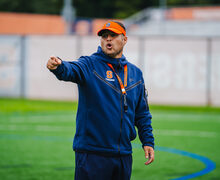Net rotation: Syracuse will utilize goaltender shift for 3rd consecutive season
Kallie Billadeau and Jenesica Drinkwater are in a constant battle.
Neither one has been given the starting goaltender role, creating a rotation in net that’s atypical of most collegiate hockey teams. Despite the fight for time on the ice, their biggest supporters might be each other.
“We’ve been friends since the second we’ve been here and we’ll be friends until the day we leave, and probably beyond,” Billadeau said.
For the past three seasons, the Orange has rotated between goalies Drinkwater and Billadeau. Head coach Paul Flanagan did not see dominance from either Billadeau or Drinkwater when they came to Syracuse, so he decided to go with the rotation.
Since that decision, they both have spent equal time in the goal.
After coaching for 31 years, Flanagan has toyed with several different rotation systems before, including the one he uses now.
“I’ve had goalies that have played 95 percent of the team’s games throughout the season,” Flanagan said. “I’ve had situations where I’ve rotated three, believe it or not. I guess I’ve had seasons where the goalie that’s playing was hot, maybe gets six or eight games. I’ve also had this similar situation where you kind of look to rotate.”
Billadeau played hockey at Hopkins High School in Minnetonka, Minn., where her coach, Vin Paolucci, said she was the “backbone of the team.” She earned almost every single start and never had to worry about rotating.
That makes the rotation she’s played in for the past three seasons unfamiliar territory for Billadeau.
“It’s something different I came from high school where I was the one goalie and played all the time,” Billadeau said. “It’s a good thing to get used to something different and I don’t know; it seems to be working out pretty well for us.”
Paolucci has been coaching in the sport of hockey for 22 years. While he admits many coaches have different philosophies, he thinks the best way to go is to have one goalie take most, if not all, of the playing time. A rotation could affect the goaltenders’ confidence.
“Every coach is a little different,” Paolucci said. “I come from the standpoint of, ‘You’re my No. 1 goalie. You’re going to have a bad game, you’re going to get right back in there and you’re going to win the next game.’”
In Paolucci’s view, Flanagan’s rotation is only utilized when neither goalie has stood out.
“I think if you got a standout goaltender, you’re not alternating,” Paolucci said. “Sometimes coaches want those kids to earn that and show it.”
When Billadeau and Drinkwater began their rotation freshman year, neither player was ever told it would continue for an extended period of time. Eventually both players made the adjustment and noticed this might be something they would need to get used to.
“You do what you’re told,” Billadeau said. “If you get the nod one night, you get the nod and you have to be there to help the team win. And if you don’t, you got to be there to support them, support Drinkwater.”
While Paolucci may feel the rotation is only because neither goalie grabbed the starting spot, Billadeau said the reason it continues is that both have been able to play consistently well.
“I think it is something that has worked for our team,” Billadeau said. “I think we’re both playing pretty well. I think, you know, just keep doing it until it doesn’t work anymore.”
Drinkwater’s mother, Cathy, has watched her daughter grow with the sport of hockey since the age of 4. She’s started many games since then. She started playing hockey through the influence of her brothers, who both loved the sport.
Against her parents’ wishes, Drinkwater only wanted to play hockey.
Now that she has reached the level of a collegiate hockey goalie, Cathy is proud of the work her daughter has done, and actually sees several benefits in the rotation the team uses.
“I think sometimes it’s good to be challenged,” Cathy said. “You shouldn’t have this expectation that you’re the be-all end-all. I think it makes you step up and work harder.”
Julie Rising was one of the first players to play for the five-year-old Syracuse ice hockey program. She graduated from college after the 2010-2011 season, which was the first year Flanagan implemented the rotation. She now coaches for the Boston Shamrocks in the North American hockey academy.
During her time on the team, she was impressed with both Billadeau and Drinkwater’s play, and saw nothing wrong with the rotation.
“I think Syracuse is really fortunate to have two strong, talented goalies in the same year,” Rising said. “Not a lot of programs have that.”
As Paolucci said, he does not see a reason the rotation should continue if someone can rise above the competition.
Drinkwater currently is stuck sitting on the sideline with an injury as Billadeau has been in goal for several shutouts. She’s even taken home the College Hockey America award for Goaltender of the Month.
According to Flanagan, though, this is a rotation that will continue.
“We believe in both of them,” Flanagan said. “They’re both good goaltenders and they both deserve to play. We don’t want either one of them sitting down.”
Published on November 6, 2012 at 2:31 am
Contact Ryan: [email protected]




